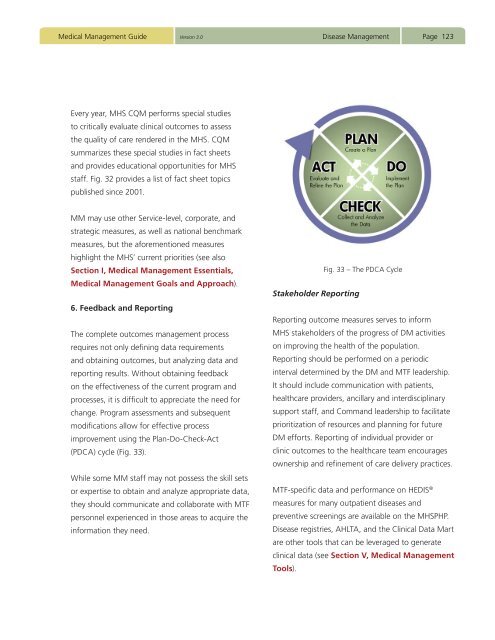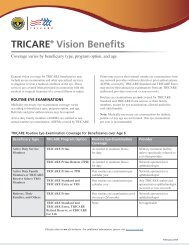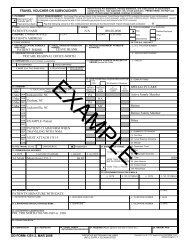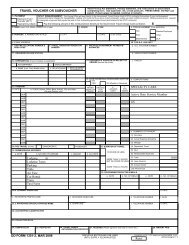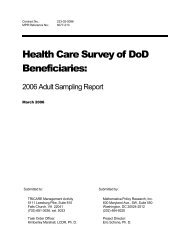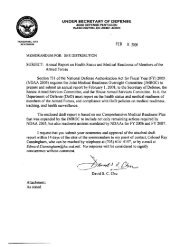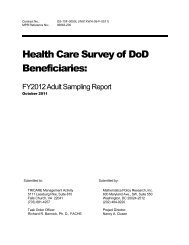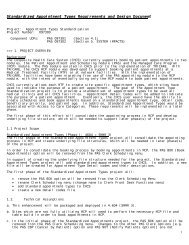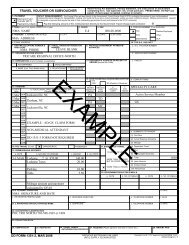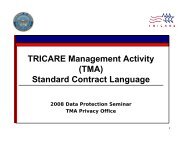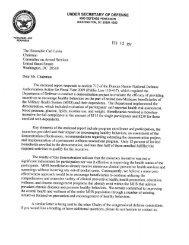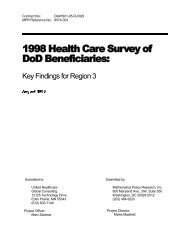Medical Management Guide, 2009, Version 3.0 - Tricare
Medical Management Guide, 2009, Version 3.0 - Tricare
Medical Management Guide, 2009, Version 3.0 - Tricare
- No tags were found...
Create successful ePaper yourself
Turn your PDF publications into a flip-book with our unique Google optimized e-Paper software.
<strong>Medical</strong> <strong>Management</strong> <strong>Guide</strong><strong>Version</strong> <strong>3.0</strong>Disease <strong>Management</strong>Page 123Every year, MHS CQM performs special studiesto critically evaluate clinical outcomes to assessthe quality of care rendered in the MHS. CQMsummarizes these special studies in fact sheetsand provides educational opportunities for MHSstaff. Fig. 32 provides a list of fact sheet topicspublished since 2001.MM may use other Service-level, corporate, andstrategic measures, as well as national benchmarkmeasures, but the aforementioned measureshighlight the MHS’ current priorities (see alsoSection I, <strong>Medical</strong> <strong>Management</strong> Essentials,<strong>Medical</strong> <strong>Management</strong> Goals and Approach).6. Feedback and ReportingThe complete outcomes management processrequires not only defining data requirementsand obtaining outcomes, but analyzing data andreporting results. Without obtaining feedbackon the effectiveness of the current program andprocesses, it is difficult to appreciate the need forchange. Program assessments and subsequentmodifications allow for effective processimprovement using the Plan-Do-Check-Act(PDCA) cycle (Fig. 33).While some MM staff may not possess the skill setsor expertise to obtain and analyze appropriate data,they should communicate and collaborate with MTFpersonnel experienced in those areas to acquire theinformation they need.Fig. 33 – The PDCA CycleStakeholder ReportingReporting outcome measures serves to informMHS stakeholders of the progress of DM activitieson improving the health of the population.Reporting should be performed on a periodicinterval determined by the DM and MTF leadership.It should include communication with patients,healthcare providers, ancillary and interdisciplinarysupport staff, and Command leadership to facilitateprioritization of resources and planning for futureDM efforts. Reporting of individual provider orclinic outcomes to the healthcare team encouragesownership and refinement of care delivery practices.MTF-specific data and performance on HEDIS ®measures for many outpatient diseases andpreventive screenings are available on the MHSPHP.Disease registries, AHLTA, and the Clinical Data Martare other tools that can be leveraged to generateclinical data (see Section V, <strong>Medical</strong> <strong>Management</strong>Tools).


